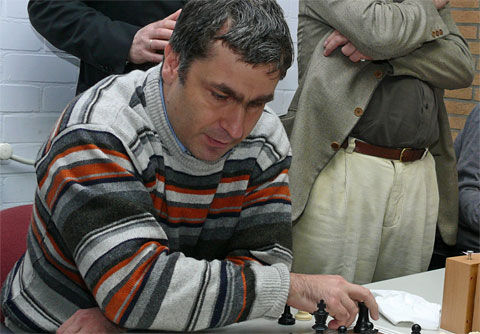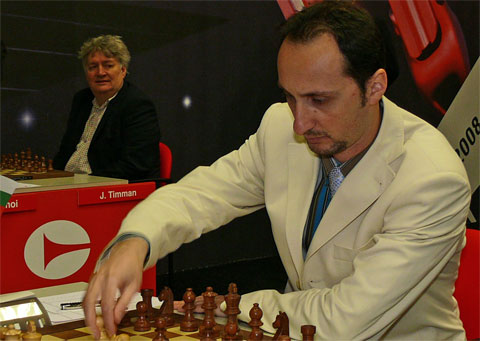Wijk aan Zee 2008

GM Mihail Marin in his analysis kitchen at home in Romania
The following express commentary was provided by Romanian grandmaster Mihail
Marin, who is the author of a number of very popular ChessBase
training CDs and articles for ChessBase Magazine. GM Marin will study the games
of the World Championship tournament in much greater detail and provide the
full results of his analysis in the next issue of ChessBase
Magazine.
Round ten commentary by GM Mihail Marin
| Group A: Round 10 - Wed. Jan. 23th |
| Loek van Wely - Magnus Carlsen |
0-1 |
| Vishy Anand - Peter Leko |
½-½ |
| Vladimir Kramnik - Boris Gelfand |
½-½ |
| Teimour Radjabov - Veselin Topalov |
½-½ |
| Shak. Mamedyarov - Judit Polgar |
½-½ |
| Pavel Eljanov - Vassily Ivanchuk |
0-1 |
| Michael Adams - Levon Aronian |
½-½ |
Playing with black against van Wely, Carlsen got into trouble soon after the
opening. Van Wely became confused when being faced on each step with the uncomfortable
task of... choosing between several winning moves! With his last two moves before
the time control he let his advantage slip away completely and then blundered
again, allowing Carlsen to start a decisive attack.

Lost the game searching for a win: Dutch GM Loek van Wely

Unlucky in round nine, lucky (loeky?) in round ten: Magnus Carlsen
Ivanchuk surprized Eljianov with a rare, but apparently quite strong move
(13...b5) in the opening and soon obtained an advantage of space in the centre.
He played with great accuracy and deservedly obtained his first victory in the
tournament.

Vassily Ivanchuk analysing
Gelfand managed to hold his own until the end against Kramnik's Queen's Indian/Catalan
setup, an outstanding achievement if we take into account the Ex-World Champion's
results with this opening nowadays!

Veselin Topalov, with Jan Timman in the background
Radjabov-Topalov featured an intense fight, with unusual structural modifications.
At some point, Topalov carried out his (formerly) trademark exchange sacrifice,
but a draw was agreed on move 47 in a position that remained complicated.
Judit Polgar surprized Mamedyarov with the... French Defence and had little
trouble equalizing. A draw was agreed in a simplified position after 28 moves.
Anand-Leko and Adams-Aronian ended in draws after 19 and 21 movs, respectively,
in positions where there seemed to be some play left still.
Van Wely,L (2681) - Carlsen,M (2733) [A58]
Corus A Wijk aan Zee NED (10), 23.01.2008 [Mihail Marin]
Both players had suffered losses in the previous round, which usually
generates a delicate psychological situation. Would they agree to a draw soon,
in order to recover properly, or, on the contrary... Well, let's see. 1.d4
Nf6 2.c4 c5 3.d5 b5. Not really a peaceful opening. 4.cxb5 a6 5.bxa6
g6 6.Nc3 Bxa6 7.Nf3 d6 8.g3 Bg7 9.Bg2 Nbd7 10.Rb1 Qa5
This early development of the queen is aimed to prevent White from regrouping
properly.
11.Bd2!? Actually, a logical move. The enemy queen is put under
indirect pressure immediately. Carlsen had obtained good counterplay after 11.0-0
Nb6 12.a3 Nc4 in his Candidate's match against Aronian, Elista 2007. The position
soon simplified and a draw was agreed.
11...Nb6 12.b3 Qa3?! But maybe this
is too much already. Carlsen might have overlooked the knight's transfer to c2,
which would cause Black additional loss of time.
13.0-0 0-0 14.Ne1 Bb7 15.Nc2
Qa6 16.e4 Ne8 17.a4 Nc7 18.Re1
White has completed his development in acceptable way, while Black's counterplay
did not really start yet.
18...Rae8. Since three of Black's minor pieces
are hitting onto the well defended d5-pawn, it is just logical to prepare the
opening of the cenre with ...e6. However, the rook's departure from the queenside
will allow White get strong initiative on what is traditionally considered "Black's
terriory" in the Volga Gambit.
19.b4! It is clear now that something
has gone terribly wrong for Black.
19...Nd7 20.Nb5!? White had many ways
to obtain a crushing advantage. Van Wely opts for a dynamic solution, which will
yield him a winning position soon. A more static, but equally unpleasant for Black
approach would be 20.b5 Qa5 21.Re3! After this rook lift, White threatens to push
the enemy queen away with Ne2, for instance 21...Nb6 22.Ne2! Qxa4 (This loses
immediately, but if the queen retreats the game would not last too long either
after the gradual but unstoppable advance of the passed pawns) 23.Ra3 Qc4 24.Ne3-+.
20...Rc8 21.Bh3 f5 22.Bg5 Ne5 23.bxc5 Qxa4 24.Nxc7 Rxc7 25.c6
White has not only preserved his extra-pawn, but has pushed it onto the 6th rank
as well! Black's position is hopeless. In the next phase of the game, Carlsen
will desperately try to fish in muddy waters.
25...Bc8 26.exf5 Rxf5!? Hoping
to get the d5-pawn some day. Which will actually happen in the game...
27.f4
Nc4 28.Rb4 Qa7+ 29.Kg2 Qc5 30.Rb8 Nb2 31.Qf3 Qxc2+ 32.Re2 Qb1
33.Bxf5 Qxf5 34.g4 Qf7 35.Bxe7 h5 36.Bxd6 hxg4 37.Qe4 Kh7
On each move, White has a choice between several completely winning moves, his
main concern being to avoid any form of black counterplay. This is quite tireing,
especially that the position looks a bit unusual.
38.Bxc7?! After this
(also winning) move, White will lose the d5-pawn, allowing Black to activate his
play in a still completely losing position. From practically point of view, it
would have been better to play 38.Rexb2 in order to make the c4-square available
for the queen (for the eventuality of ...Bf5). After 38...Bxb2 White can play
39.Bxc7 already.
38...Bf5
The situation has become slightly obscure. In order to retain his decisive advantage,
hite has to do some calculation.
39.Qe3?! This move, probably dictated
by the natural desire to keep the own king defended, throws away the biggest part
of the advantage. From practical point of view, 39.Rh8+! would have been the simplest
way to a win, because it would have led to the forced exchange of queens and the
unstoppable advance of the far advanced passed pawns.; In the heat of the fight
and under time pressure it is not easy to spot the other winning move 39.Qe7 ,
creating the unpleasant threat of Qh4+. The point is that after 39...Qxd5+ 40.Kg1
(But not
40.Kg3?? because of
40...Qf3+ followed by mate.
In fact, if you see this during the game, you do not feel like investigating the
consequences of 39.Qe7 anymore)
) 40...Qd1+ 41.Kf2 Qd4+ 42.Kg3 Qg1+ 43.Kh4
the king escapes from checks and is ready to participate to the creation of a
mating net around his colleague!
39...Qxd5+
40.Kg3? After this new inaccuracy, the game should end in a draw. The
paradoxical 40.Kg1!? would have retained some advantage for White, because the
aparently winning 40...Bd4 (Black has nothing better) 41.Rh8+! followed by Be5(+)
would again force favourable simplifications. It is true that after the elimination
of the d5-pawn things are not the same as after 39.Rh8!+...
40...Nc4
41.Qf2? The losing move. It must have been hard for van Wely to switch
from the choosing-between-several-absolutely-winning-moves mode to finding-the-only-saving-move.
Anyway, it was essential to maintain the third rank defended with 41.Qb3 when
after 41...Qh1 42.Be5 the game should end in a draw by perpetual. 41...Qd3+
42.Kg2 Be4+. Black's attack is decisive now. Unlike his opponent, Carlsen
adapted himself to the new circumstances perfectly. 43.Rxe4 Qxe4+ 44.Kf1
Qd3+ 45.Qe2 Nd2+ 46.Ke1 Nf3+ 47.Kf1 Nxh2+ 48.Ke1 Bc3+ 49.Kf2 g3+ 0-1.
[Click to replay]
Eljanov,P (2692) - Ivanchuk,V (2751) [E00]
Corus A Wijk aan Zee NED (10), 23.01.2008 [Mihail Marin]
1.d4 Nf6 2.c4 e6 3.g3 Bb4+ 4.Bd2 Be7 5.Bg2 d5 6.Nf3 c6 7.0-0 Nbd7 8.Nc3
0-0 9.Bf4 Nh5 10.Bc1 Nhf6 11.Bf4 Nh5 12.Bc1 Nhf6
After nine consecutive draws, Ivanchuk did not seem to be in a great fighting
mood.
13.Nd2. However, Eljanov, who also had not won a single game in this
tournament, decided that a draw in just 13 moves would be an undesired record
and avoids the repetition.
13...b5!? This move, implying a temporary pawn
sacrifice, has only rarely been played here, although it is Black's only way to
hope for an adequate position. If White is allowed to open the centre with e4,
he would obtain a clear advantage.
14.cxb5. In the Catalan, the standard
reaction to the advance of the b-pawn is 14.c5 , but here Black can obtain counterplay
in the centre immediately with 14...e5.
14...cxb5 15.Nxb5 Qb6 16.Qa4 Bb7 17.Nc3
Bc6 18.Qc2 Qxd4 19.Nb3 Qb6 20.Be3 Qa6
After a more or less forced sequence of moves, White has completed his development.
Optically, he seems to have an active position, but Black's advantage of space
in the centre is not easy to challenge. Eljanov might have felt at home in this
position, because, if we reverse colours, it strongly ressembles his favourite
opening with Black against 1.d4, the Grünfeld.
21.Nd4. Four decades ago,
Larsen played 21.f4 , aiming to keep the enemy centre under control. Later, he
installed his bishop on d4 and gradually simplified the position. The resulting
endgame was only microscopically better for White, but Larsen went on winning.
21...Bb7 22.Bg5 Rfc8 23.Rfc1 e5
White loses stability in the centre and Ivanchuk will neutralize his piece pressure
by relatively simple means.
24.Nf5 Bf8 25.Qd3 Qe6 26.Nh4. Not a great
square for the knight, but 26.Bh3?! Kh8! leaves White pinned and hanging.
26...h6
27.Bxf6 Nxf6 28.Qd1 Rab8
Black completes his development, creating the strong threat ...d4 at the same
time. Lacking space and with his pieces passively placed, White is in trouble
already.
29.e3 d4! 30.exd4 Bxg2 31.Nxg2 Rxb2 32.dxe5 Qxe5
By means of a simple exchange operation, Black has transformed his advantage of
space into superior piece activity in a symmetrical position. White has problems
maintaining the a2- and f2-pawns defended.
33.Qe1 Bd6!? Black is not against
the exchange of queens in general, but does not wish to lose the initiative by
carrying out the exchange himself. After 33...Qxe1+ White would get some hopes
to activate his g2-knight with 34.Nxe1 followed by Nd3. On the contrary, after
the text move the exchange on e5 would activate the black bishop in radical way.
34.Nd5. White releases the pressure by simplifying the position, but this
will cost him a pawn.
34...Rxc1 35.Nxf6+ Qxf6 36.Rxc1 Rxa2 37.Nf4 Qf5 38.Qe3
a5 39.Qd4 Bf8 40.Qd8
Apparently, White has obtained some counterplay. However, the weakened position
of his own king leaves him without real hopes of saving the game.
40...Qe4
41.Nd5 Re2 42.Rf1 Qa4 43.Nc3 Re8 44.Qc7 Qa3 45.Rd1 Bb4 46.Qd7 Kf8 47.Nd5 Qf3 48.Nxb4
axb4 49.Rb1 b3 50.Qb5
Apparently, White is just one step away from winning the b-pawn and achieving
a draw. True, Qxb3 is not a threat because of ...Re1!+, but after the intermediate
Qb4+, it will be possible to play Rxb3, because the e1-square would remain defended.
However, it is Black's turn to move... 50...Re2 51.Qb8+ Ke7! Remarkably,
the king feels entirely safe outside his residence. This is explained by the
complete passivity of the enemy rook. 52.Qc7+ Kf6 53.Qb6+ Kf5 54.h3.
The king would escape checks after 54.Qb5+ Kg4 55.Qd7+ Kh5 56.Qb5+ g5. 54...f6
55.Qd4 b2 56.Kf1 Rc2 and in view of the threats Qh1 mate or ...Rc1+, White
resigned. 0-1. [Click
to replay]

CORUS CHESS MEET 2008 Round 10
Interviews with Michael Adams, Vassily Ivanchuk, Etienne Bacrot and Parimarjan
Negi. Author: Vijay Kumar.
Links







